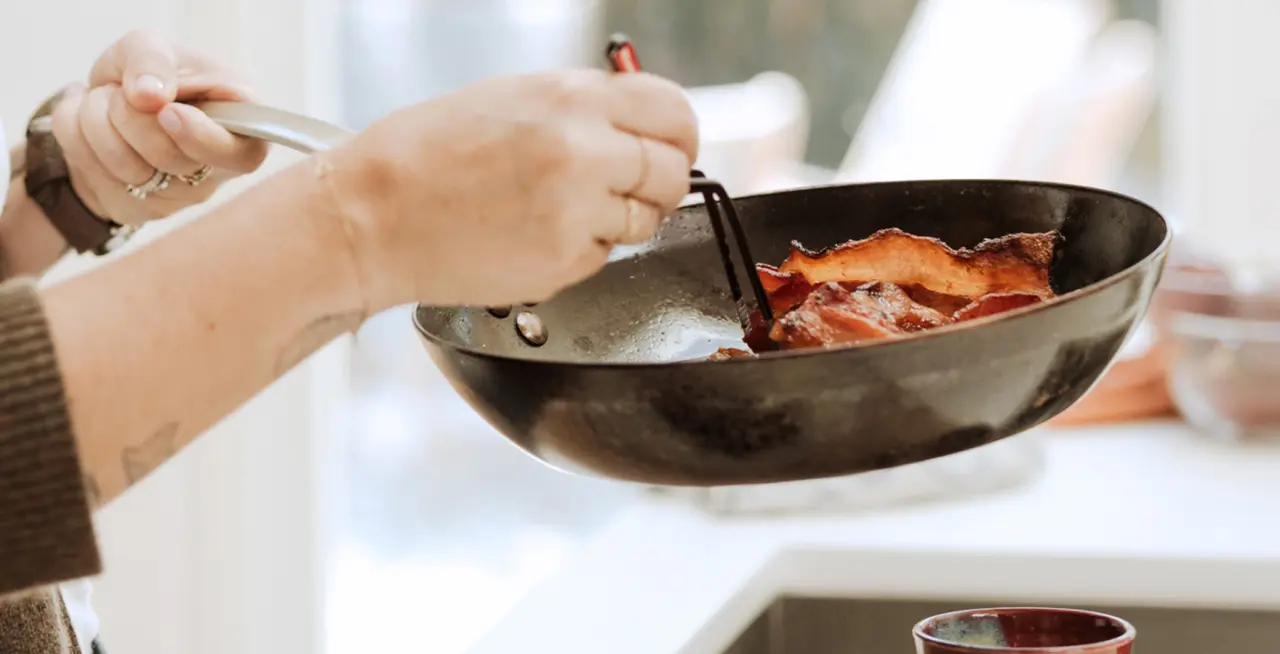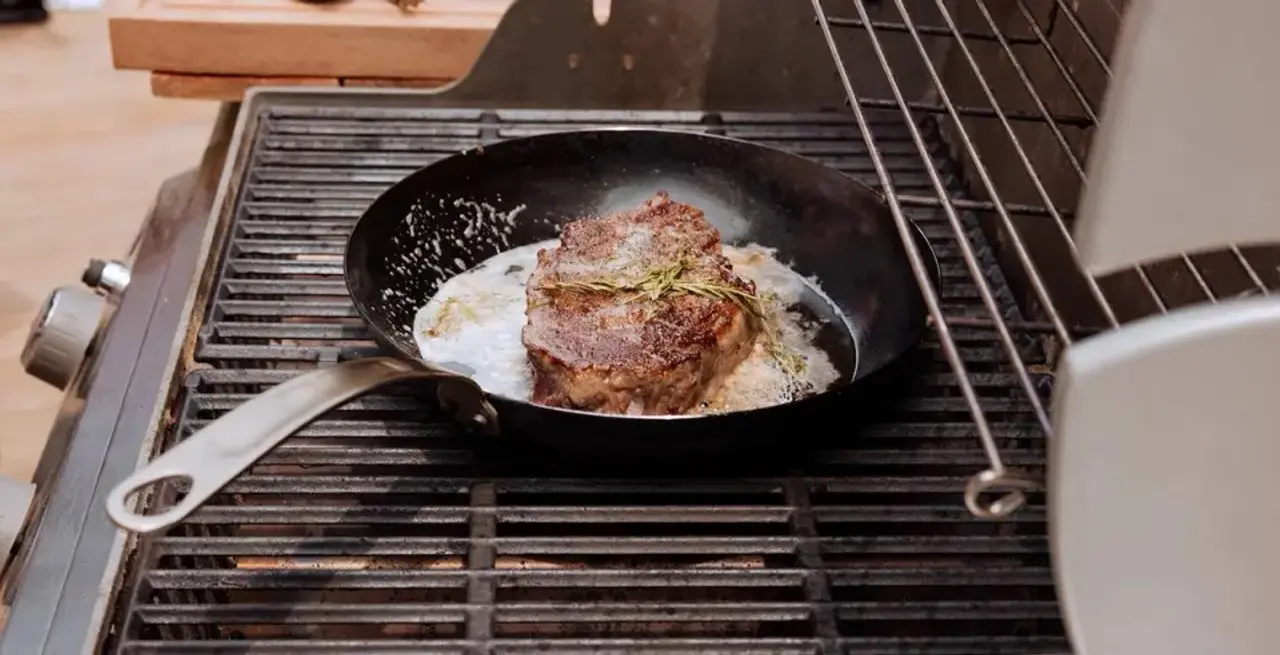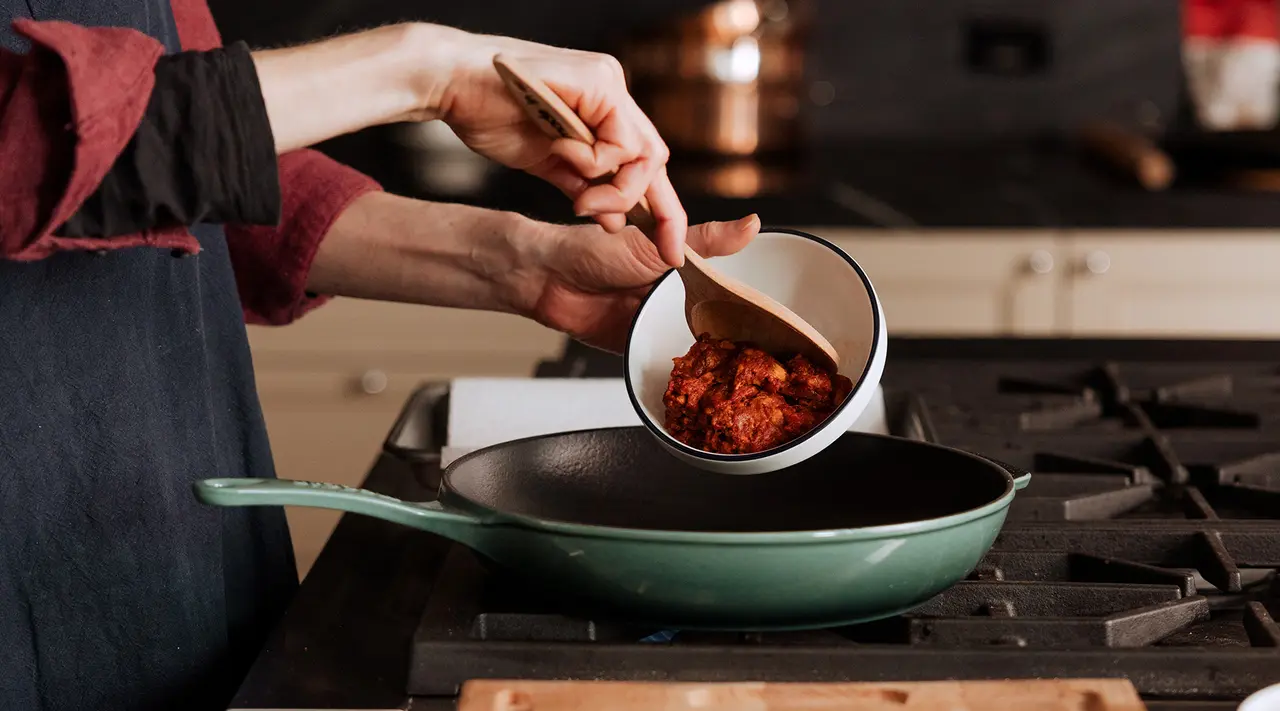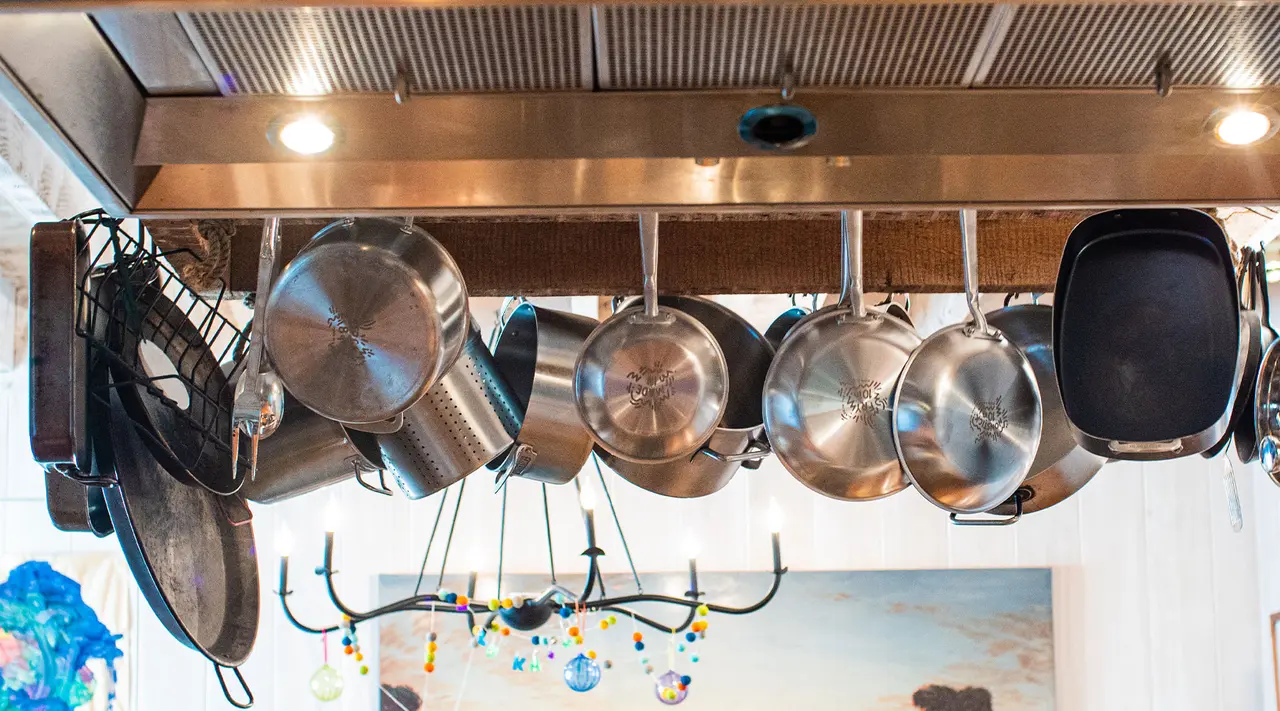Learn the difference between these two high-heat materials once and for all.

Cast iron and carbon steel cookware are so similar that it can be easy to confuse the two. Both materials are highly durable, made from iron alloys, and are two of the heaviest duty cookware materials available.
However, they’re far from the same. Cast iron is created using iron and between 2% and 4% carbon, resulting in a far heavier product than carbon steel alternatives, which reduce carbon content to just 1%. This seemingly subtle difference means that each material has distinct advantages—and disadvantages—in different situations.
Let’s dive in.
Carbon steel is a combination of approximately 99% iron and 1% carbon, which is spun and stamped to form the cookware you know and love. It’s a staple in restaurant kitchens, where chefs rely on its durable versatility, naturally non stick surface, and long lifespan to execute perfect dinner services day after day.
While carbon steel usually features a dark matte finish, our Blue Carbon Steel earns its name from its annealing process that protects the pans from corrosion in transit, which both darkens the metal and lends it a blue tint.
Carbon steel cookware combines some of the best properties of stainless steel and cast iron, making it a popular choice among chefs and home cooks alike. Some of the materials’ biggest advantages include its lightweight, durable properties and quick heat response.
Advantage 1: Light weight
While carbon steel has many of the same benefits as cast iron, the material is not as heavy to wield. The lightness and durability of carbon steel means that it’s perfect to cook with both in and outside of the kitchen.
Advantage 2: Durability
While carbon steel is lightweight, it’s also highly durable. This hard metal material is known to serve as a workhorse in the kitchen, and doesn’t easily dent or ding. With proper maintenance, carbon steel cookware can last for decades.
Advantage 3: Fast Heat Response
Because carbon steel is lightweight, it’s known to heat up quickly—a plus for impatient or hangry cooks. It’s also the ideal choice for high-heat cooking on the stove, grill, and/or open fire.
While carbon steel certainly has its pluses, there are some situations where cast iron may be preferable.
Consideration 1: Low Heat Retention
It’s true that carbon steel heats quickly. However, compared to thicker (and slower to heat) cast iron, carbon steel doesn’t retain heat as well.
Consideration 2: Maintenance
Carbon steel and cast iron follow similar maintenance regimes. However, since carbon steel contains a higher percentage of iron, it’s more susceptible to rust and corrosion. Fortunately, it’s much simpler to season compared to cast iron.
We advise all users of both materials to keep tools away from moisture, humidity, metal utensils, and acidic foods to extend their lifespans.
Consideration 3: Seasoning Required
Like cast iron, carbon steel pans require seasoning to maintain a rust-free, non stick surface. Cooking with an unseasoned pan inevitably causes food to stick, so you’ll either want to purchase pre-seasoned carbon steel cookware or otherwise properly season it yourself before cooking.
Compared to cast iron, carbon steel is far simpler to season. Both materials have microscopic pores across their surfaces, which can cause problems with sticking. Seasoning fills in the minute craters, leveling out the surface and filling in gaps where ingredients may otherwise get snagged. But because carbon steel’s “pores” are much smaller, they’re easier to fill in and less prone to snagging ingredients, so sticking is less common and seasoning (or reseasoning) is easier to maintain.
Carbon steel cookware is known for its incredible durability. But how does it compare to materials like aluminum, stainless steel, and non-stick?
Take a look at the guides below for answers to all of your questions:
Cast iron cookware is made by pouring molten iron alloy into molds. From there, the pieces are either finished with a manually applied ceramic-based coating to create enameled cast iron, or left unfinished, like the archetypal heavy-duty black skillets gracing stovetops everywhere.. Because of its weight and slowness, cast iron is not common in restaurant kitchens.
You’re sure to find cast iron cookware in almost every American home kitchen, though from the serious chef to the casual cook. It’s an affordable and readily available material that’s been used and handed down for generations—and for good reason(s).
Advantage 1: Natural Non-stick Finish
When cast iron has been properly seasoned, it features a non-stick finish that easily releases food as you cook. Unlike other pans that rely on the addition of a chemical-based non stick coating to create a frictionless surface, cast iron’s finish is entirely natural and improves with regular use.
Advantage 2: High Heat Retention
Cast iron is made from thick, molded metal that retains heat well. The material can withstand heat from gas stoves, ovens, electric burners, and even live coals. As long as the burner or heat source is the same size as the base of your pot or pan, your food should cook evenly in cast iron—though it may take a while.
Advantage 3: Easy to Clean
Even though you can’t drop your cast iron cookware into the dishwasher, it’s not difficult to clean. Simply add a drop of dish soap, scrub out leftover food with a scouring pad, and rinse it. Dry the pan with a towel and rub a few drops of oil over its surface (or complete a quick round of reseasoning) to preserve its non-stick properties.
Due to its thick iron walls, cast iron pans are highly durable—essentially indestructible. The downside of this is that they heat slowly and can be difficult to maneuver.
Consideration 1: Heats Slowly
Cast iron heats slowly, and there’s no way around it. You may have to spend five to ten minutes preheating the pan before you can get to the main event. However, once the pan is heated, it does a great job of maintaining steady temperatures.
Consideration 2: High Heat Causes Food to Stick
Since cast iron heats slowly, you may be tempted to turn the burner to a high temperature to speed things along. However, cast iron’s heat retention means that once it's hot, it won’t cool back down easily. If you find your food sticking to your well-seasoned pan, it’s very likely because the burner was too hot. Chefs recommend using only medium heat when cooking with cast iron.
Consideration 3: Heavy to Maneuver
Cast iron’s solidity comes at a price for those looking for lightweight or easily maneuverable cookware. At about half the weight, carbon steel is a much more nimble and wrist-friendly material.
Cast iron is a durable heavy-weight in the kitchen that can withstand a variety of heat sources while featuring a natural non-stick finish.
Take a look at how the material stands up to stainless steel and non-stick with our guides on cast iron vs. stainless steel and enameled cast iron vs. non stick.
Both carbon steel and cast iron cookware are durable pieces able to withstand regular use. However, there are a few differences to consider if you’re looking to add a new piece to your kitchen.
Carbon steel tends to heat much quicker than cast iron, but features slightly lower heat retention. On the other hand, cast iron can hold steady heat, but takes a while to get there and may cause food to stick if the heat is too high.
Each material serves different needs, which is why you’ll find both types of cookware in a serious cook’s kitchen.
Let’s take a look at which pan is right for yours.
Now that you’ve seen what cast iron and carbon steel cookware is capable of, it’s time to decide on the best material for you.
Consider the following:
If you’re looking for a new piece of cookware to add to your kitchen, you can’t go wrong with cast iron or carbon steel. Both materials certainly have their own advantages and disadvantages, but can withstand heavy-duty use while lasting for decades with the proper care.
Both our Enameled Cast Iron and Carbon Steel Collections are made by multi-generational artisans in France and Sweden, and are beloved by home cooks and restaurant customers alike. Whether you opt for one over the other or both, you're sure to see the difference in chef-loved cookware.
We use cookies to provide a better user experience. By using our site, you agree to our use of cookies. See our Privacy Policy to learn more.


